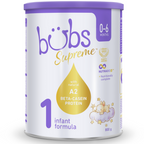How To Puree Baby Food For Your Bub
Introducing solid foods to your baby is a significant milestone, and what better way to do it than with wholesome, homemade purees? The benefits of preparing homemade baby food extend beyond just nutritional value; it's an opportunity to exercise control over ingredients, ensure freshness and customise flavours to suit your baby's evolving palate.
Why Homemade Baby Food?
Homemade baby food holds a special place in the hearts of parents for numerous reasons. The control over ingredients ensures that your baby receives only the freshest and healthiest options. This approach allows for customisation, catering to your baby's taste preferences and dietary requirements. As an excellent on-the-go option, Bubs' Plant Burst Pouches offer a range of ingredient combinations, providing convenience without compromising on quality.
When Do Babies Start Eating Pureed Food?
The timing of introducing pureed foods is pivotal for a baby's developmental needs. While readiness signs may vary among babies, a general recommendation is to start introducing baby puree recipes around six months of age. This timeframe aligns with the gradual transition from a solely milk-based diet to incorporating solids, meeting the growing nutritional demands of your little one.
What Foods Can Be Pureed?
Choosing the right foods for pureeing is crucial for providing essential nutrients and introducing varied flavours and textures. For the early stages of infancy, consider nutrient-rich foods like avocado, sweet potato, peas and bananas. As your baby progresses, explore a wider range of baby puree recipes, including apples, pears and well-cooked grains. The key is introducing a diverse range of foods to encourage a broad palate.
How to Puree Baby Food
When learning how to puree baby food, ensure you have all the basic tools to make your life as easy as possible. Start with the basics: a good peeler, a reliable blender or food processor and, of course, fresh, organic produce. Ensure you thoroughly wash all fruits and vegetables before use to remove contaminants. For optimal nutrient retention, consider steaming or cooking the ingredients gently before blending to achieve smooth and palatable purees.
How to Store Homemade Baby Puree
Once the purees are ready, proper storage is essential to preserve their freshness and nutritional value. Invest in BPA-free containers suitable for freezing and label them with the date of preparation. This not only helps in keeping track of freshness but also aids in organising a variety of purees for babies.
How to Reheat Frozen Baby Food Puree
When reheating frozen baby food, a gentle approach is key to maintaining its quality. Thaw the puree in the refrigerator the night before to ensure a gradual thawing process. While microwaving is an option for quick thawing, be cautious about potential nutrient loss and uneven heating. If opting for the microwave, heat in short intervals, stirring in between, and always check the temperature before feeding to avoid burns.
The journey of preparing homemade baby food is a delightful and rewarding one. Beyond providing essential nutrients, it fosters a connection between parents and their little ones during this crucial phase of nutritional development. The joy of crafting unique flavours, exploring textures and witnessing your baby's reactions to new baby puree recipes is unparalleled.


